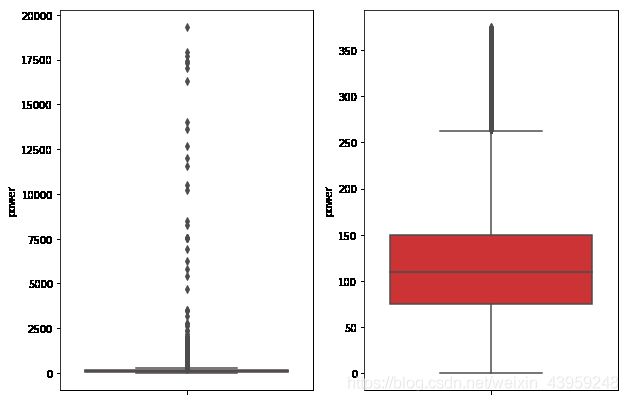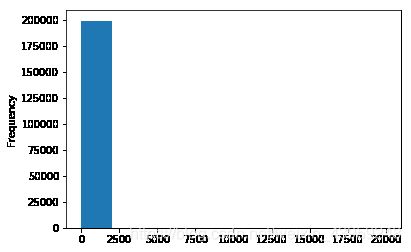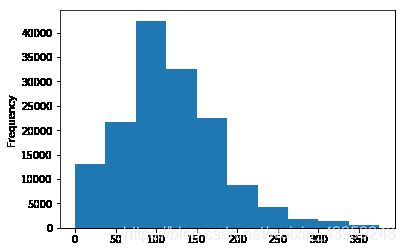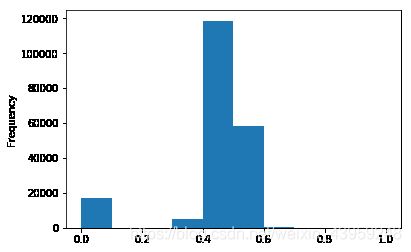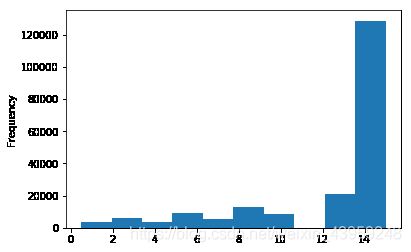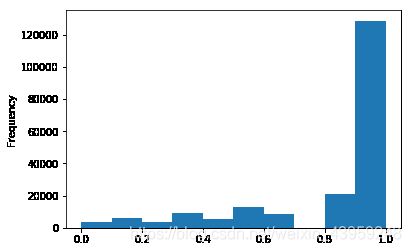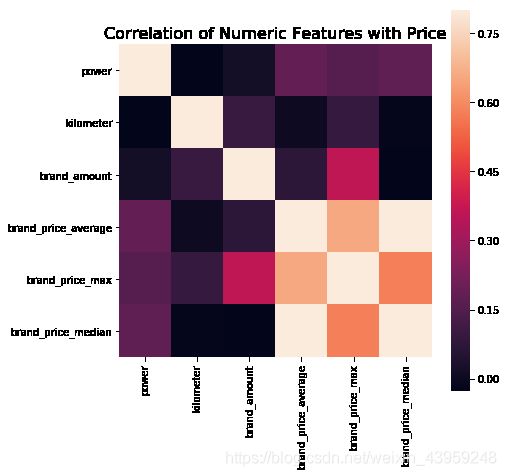数据挖掘TASK3_特征工程
特征工程
目标
对于特征进行进一步分析,并对于数据进行处理
完成对于特征工程的分析,并对于数据进行一些图表或者文字总结并打卡。
内容
常见的特征工程包括:
1、异常处理:
通过箱线图(或 3-Sigma)分析删除异常值;
BOX-COX 转换(处理有偏分布);
长尾截断;
2、特征归一化/标准化:
标准化(转换为标准正态分布);
归一化(抓换到 [0,1] 区间);
针对幂律分布,可以采用公式: l o g ( 1 + x 1 + m e d i a n ) log(\frac{1+x}{1+median}) log(1+median1+x)
3、数据分桶:
等频分桶;
等距分桶;
Best-KS 分桶(类似利用基尼指数进行二分类);
卡方分桶;
4、缺失值处理:
不处理(针对类似 XGBoost 等树模型);
删除(缺失数据太多);
插值补全,包括均值/中位数/众数/建模预测/多重插补/压缩感知补全/矩阵补全等;
分箱,缺失值一个箱;
5、特征构造:
构造统计量特征,报告计数、求和、比例、标准差等;
时间特征,包括相对时间和绝对时间,节假日,双休日等;
地理信息,包括分箱,分布编码等方法;
非线性变换,包括 log/ 平方/ 根号等;
特征组合,特征交叉;
仁者见仁,智者见智。
6、特征筛选
过滤式(filter):先对数据进行特征选择,然后在训练学习器,常见的方法有 Relief/方差选择发/相关系数法/卡方检验法/互信息法;
包裹式(wrapper):直接把最终将要使用的学习器的性能作为特征子集的评价准则,常见方法有 LVM(Las Vegas Wrapper) ;
嵌入式(embedding):结合过滤式和包裹式,学习器训练过程中自动进行了特征选择,常见的有 lasso 回归;
7、降维
PCA/ LDA/ ICA;
特征选择也是一种降维。
代码
import pandas as pd
import numpy as np
import matplotlib
import matplotlib.pyplot as plt
import seaborn as sns
from operator import itemgetter
path = 'C:/Users/lenovo/Desktop/data/'
train = pd.read_csv(path+'used_car_train_20200313.csv', sep=' ')
test = pd.read_csv(path+'used_car_testA_20200313.csv', sep=' ')
print('Train data shape:', train.shape)
print('Test data shape:', test.shape)
Train data shape: (150000, 31)
Test data shape: (50000, 30)
#train.head()
#test.head()
train.columns
Index(['SaleID', 'name', 'regDate', 'model', 'brand', 'bodyType', 'fuelType',
'gearbox', 'power', 'kilometer', 'notRepairedDamage', 'regionCode',
'seller', 'offerType', 'creatDate', 'price', 'v_0', 'v_1', 'v_2', 'v_3',
'v_4', 'v_5', 'v_6', 'v_7', 'v_8', 'v_9', 'v_10', 'v_11', 'v_12',
'v_13', 'v_14'],
dtype='object')
test.columns
Index(['SaleID', 'name', 'regDate', 'model', 'brand', 'bodyType', 'fuelType',
'gearbox', 'power', 'kilometer', 'notRepairedDamage', 'regionCode',
'seller', 'offerType', 'creatDate', 'v_0', 'v_1', 'v_2', 'v_3', 'v_4',
'v_5', 'v_6', 'v_7', 'v_8', 'v_9', 'v_10', 'v_11', 'v_12', 'v_13',
'v_14'],
dtype='object')
data_series = train['power']
data_series.shape[0]
150000
def outliers_proc(data, col_name, scale=3):
"""
用于清洗异常值,默认用 box_plot(scale=3)进行清洗
:param data: 接收 pandas 数据格式
:param col_name: pandas 列名
:param scale: 尺度
:return:
"""
def box_plot_outliers(data_ser, box_scale):
"""
利用箱线图去除异常值
:param data_ser: 接收 pandas.Series 数据格式
:param box_scale: 箱线图尺度,
:return:
"""
iqr = box_scale * (data_ser.quantile(0.75) - data_ser.quantile(0.25))
val_low = data_ser.quantile(0.25) - iqr
val_up = data_ser.quantile(0.75) + iqr
print('下界限、上界线分别是', val_low, val_up)
rule_low = (data_ser < val_low) #低于最低数的异常值
rule_up = (data_ser > val_up) #高于最高数的异常值
return (rule_low, rule_up), (val_low, val_up)
data_n = data.copy()
data_series = data_n[col_name]
rule,value = box_plot_outliers(data_series, box_scale=scale)
index = np.arange(data_series.shape[0])[rule[0]|rule[1]]#得到异常值的索引
print('Delete number is:{}'.format(len(index)))
data_n = data_n.drop(index) #【删除】有异常值的样本
print(data_n.shape)
data_n.reset_index(drop=True, inplace=True)
print('now column number is {}'.format(data_n.shape[0])) #剩下的样本数
index_low = np.arange(data_series.shape[0])[rule[0]]
outliers = data_series.iloc[index_low] #有异常值的样本列
print("Description of data less than the lower bound is:")
print(pd.Series(outliers).describe())
index_up = np.arange(data_series.shape[0])[rule[1]]
outliers = data_series.iloc[index_up] #有异常值的样本列
print("Description of data larger than the upper bound is:")
print(pd.Series(outliers).describe())
fig, ax = plt.subplots(1,2,figsize=(10,7))
sns.boxplot(y=data[col_name], data=data, palette="Set1", ax=ax[0])
sns.boxplot(y=data_n[col_name], data=data_n, palette="Set1", ax=ax[1])
return data_n
train = outliers_proc(train, 'power', scale=3)
下界限、上界线分别是 -150.0 375.0
Delete number is:963
(149037, 31)
now column number is 149037
Description of data less than the lower bound is:
count 0.0
mean NaN
std NaN
min NaN
25% NaN
50% NaN
75% NaN
max NaN
Name: power, dtype: float64
Description of data larger than the upper bound is:
count 963.000000
mean 846.836968
std 1929.418081
min 376.000000
25% 400.000000
50% 436.000000
75% 514.000000
max 19312.000000
Name: power, dtype: float64
#把训练集和测试集放在一起,方便构造特征
train['train'] = 1
test['train'] = 0
data = pd.concat([train, test], ignore_index=True, sort=False)
#计算汽车使用的时间,使用时间越短价格越高
data['used_time'] = (pd.to_datetime(data['creatDate'], format='%Y%m%d', errors='coerce') -
pd.to_datetime(data['regDate'], format='%Y%m%d', errors='coerce')).dt.days
data['used_time'].isnull().sum()
#从邮编中提取城市信息
data['city'] = data['regionCode'].apply(lambda x: str(x)[:-3])
train_gb = train.groupby('brand') #将样本按照brand分类
all_info={
}
for kind, kind_data in train_gb:
info = {
}
kind_data = kind_data[kind_data['price']>0]
#该品牌共有多少量汽车
info['brand_amount'] = len(kind_data)
info['brand_price_max'] = kind_data.price.max()
info['brand_price_median'] = kind_data.price.median()
info['brand_price_min'] = kind_data.price.min()
info['brand_price_sum'] = kind_data.price.sum()
info['brand_price_std'] = kind_data.price.std()
info['brand_price_average'] = round(kind_data.price.sum()/(len(kind_data)+1), 2)
all_info[kind] = info #统计不同brand汽车价格的各个统计量
brand_fe = pd.DataFrame(all_info).T.reset_index().rename(columns={
'index':'brand'})
#print(brand_fe.head())
#print(data.head())
data = pd.merge(data,brand_fe, how='left', on='brand') #将该品牌汽车的各个统计量添加到表格中
bin = [i*10 for i in range(31)] #设定汽车的power区间
data['power_bin'] = pd.cut(data['power'], bin, labels=False) #划分区间
data[['power_bin', 'power']].head()
#删掉createdata regdata regioncode这些原始数据
data = data.drop(['creatDate', 'regDate', 'regionCode'], axis=1)
print(data.shape)(199037, 39)
print(data.columns)
Index(['SaleID', 'name', 'model', 'brand', 'bodyType', 'fuelType', 'gearbox',
'power', 'kilometer', 'notRepairedDamage', 'seller', 'offerType',
'price', 'v_0', 'v_1', 'v_2', 'v_3', 'v_4', 'v_5', 'v_6', 'v_7', 'v_8',
'v_9', 'v_10', 'v_11', 'v_12', 'v_13', 'v_14', 'train', 'used_time',
'city', 'brand_amount', 'brand_price_average', 'brand_price_max',
'brand_price_median', 'brand_price_min', 'brand_price_std',
'brand_price_sum', 'power_bin'],
dtype='object')
#将数据导出,用于树模型使用
data.to_csv('data_for_tree.csv', index=0)
#构造特征给线性回归LR模型使用
data['power'].plot.hist()
train['power'].plot.hist()
# 我们对power取 log,在做归一化
from sklearn import preprocessing
min_max_scaler = preprocessing.MinMaxScaler()
data['power'] = np.log(data['power'] + 1)
data['power'] = ((data['power'] - np.min(data['power'])) / (np.max(data['power']) - np.min(data['power'])))
data['power'].plot.hist()
#kilometer已经做过分桶
data['kilometer'].plot.hist()
#直接归一化
data['kilometer'] = ((data['kilometer'] - np.min(data['kilometer'])) /
(np.max(data['kilometer']) - np.min(data['kilometer'])))
data['kilometer'].plot.hist()
#对刚构造的统计量,均归一化
data['brand_amount'] = ((data['brand_amount'] - np.min(data['brand_amount'])) /
(np.max(data['brand_amount']) - np.min(data['brand_amount'])))
data['brand_price_average'] = ((data['brand_price_average'] - np.min(data['brand_price_average'])) /
(np.max(data['brand_price_average']) - np.min(data['brand_price_average'])))
data['brand_price_max'] = ((data['brand_price_max'] - np.min(data['brand_price_max'])) /
(np.max(data['brand_price_max']) - np.min(data['brand_price_max'])))
data['brand_price_median'] = ((data['brand_price_median'] - np.min(data['brand_price_median'])) /
(np.max(data['brand_price_median']) - np.min(data['brand_price_median'])))
data['brand_price_min'] = ((data['brand_price_min'] - np.min(data['brand_price_min'])) /
(np.max(data['brand_price_min']) - np.min(data['brand_price_min'])))
data['brand_price_std'] = ((data['brand_price_std'] - np.min(data['brand_price_std'])) /
(np.max(data['brand_price_std']) - np.min(data['brand_price_std'])))
data['brand_price_sum'] = ((data['brand_price_sum'] - np.min(data['brand_price_sum'])) /
(np.max(data['brand_price_sum']) - np.min(data['brand_price_sum'])))
# 对类别特征进行 OneEncoder
data = pd.get_dummies(data, columns=['model', 'brand', 'bodyType', 'fuelType',
'gearbox', 'notRepairedDamage', 'power_bin']) #提取不同的类别作为特征名,每个样本属于这个特征则编码为1
#data.head()
print(data.columns)
Index(['SaleID', 'name', 'power', 'kilometer', 'seller', 'offerType', 'price',
'v_0', 'v_1', 'v_2',
...
'power_bin_20.0', 'power_bin_21.0', 'power_bin_22.0', 'power_bin_23.0',
'power_bin_24.0', 'power_bin_25.0', 'power_bin_26.0', 'power_bin_27.0',
'power_bin_28.0', 'power_bin_29.0'],
dtype='object', length=370)
data.shape
#data.head()
(199037, 370)
#data.to_csv('data_for_lr.csv',index=0)
#特征筛选
#过滤式——相关性分析
print(data['power'].corr(data['price'], method='spearman'))
print(data['kilometer'].corr(data['price'], method='spearman'))
print(data['brand_amount'].corr(data['price'], method='spearman'))
print(data['brand_price_average'].corr(data['price'], method='spearman'))
print(data['brand_price_max'].corr(data['price'], method='spearman'))
print(data['brand_price_median'].corr(data['price'], method='spearman'))
0.5728285196051496
-0.4082569701616764
0.058156610025581514
0.3834909576057687
0.259066833880992
0.38691042393409447
# 当然也可以直接看图
data_numeric = data[['power', 'kilometer', 'brand_amount', 'brand_price_average',
'brand_price_max', 'brand_price_median']]
correlation = data_numeric.corr()
f , ax = plt.subplots(figsize = (7, 7))
plt.title('Correlation of Numeric Features with Price',y=1,size=16)
sns.heatmap(correlation,square = True, vmax=0.8)
#包裹式分析
# k_feature 太大会很难跑,没服务器,所以提前 interrupt 了
from mlxtend.feature_selection import SequentialFeatureSelector as SFS
from sklearn.linear_model import LinearRegression
sfs = SFS(LinearRegression(),
k_features=10,
forward=True,
floating=False,
scoring = 'r2',
cv = 0)
x = data.drop(['price'], axis=1)
x = x.fillna(0)
y = data['price']
sfs.fit(x, y)
sfs.k_feature_names_
---------------------------------------------------------------------------
ModuleNotFoundError Traceback (most recent call last)
in ()
1 #包裹式分析
2 # k_feature 太大会很难跑,没服务器,所以提前 interrupt 了
----> 3 from mlxtend.feature_selection import SequentialFeatureSelector as SFS
4 from sklearn.linear_model import LinearRegression
5 sfs = SFS(LinearRegression(),
ModuleNotFoundError: No module named 'mlxtend'
# 画出来,可以看到边际效益
from mlxtend.plotting import plot_sequential_feature_selection as plot_sfs
import matplotlib.pyplot as plt
fig1 = plot_sfs(sfs.get_metric_dict(), kind='std_dev')
plt.grid()
plt.show()
